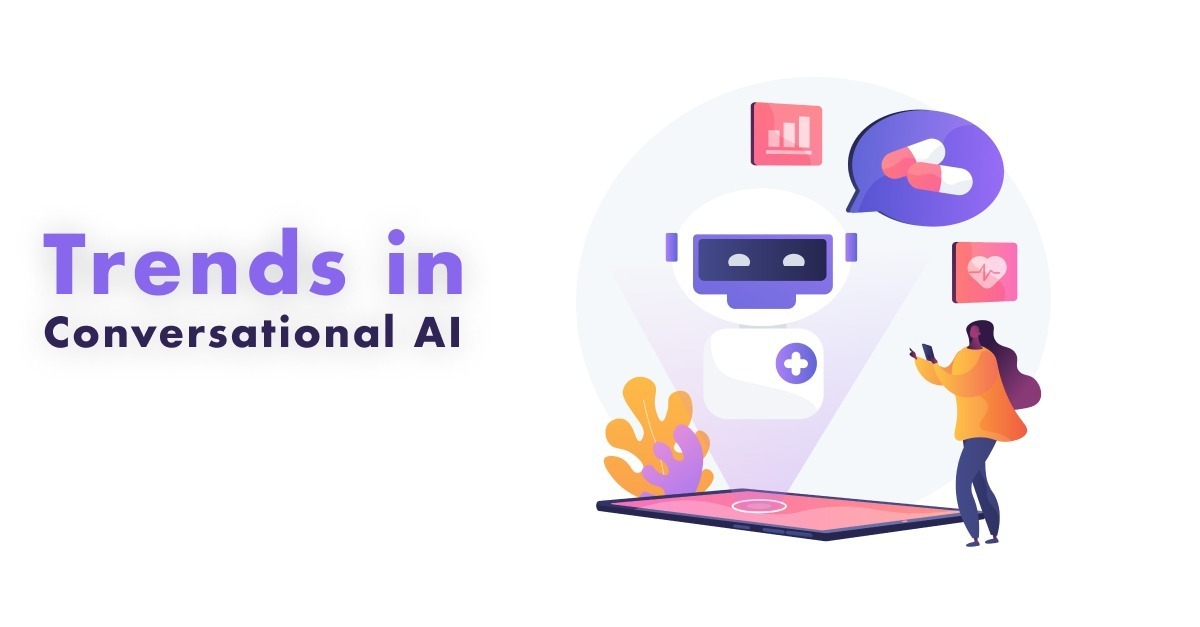
AI’s undeniable march into the future is making our digital lives easier than ever, and conversational AI is leading the charge. This hot topic, with its market value soaring from $40.9 million in 2018 to a projected $454.8 million by 2027, is driven by exciting trends in conversational AI. We’re seeing smarter interactions that feel truly human, seamless omnichannel experiences, personalization that anticipates your needs, and proactive assistance that streamlines your life. The future of interacting with machines is bright, and AI is lighting the way.
Looking forward to 2024, it’s clear that conversational AI will remain at the forefront of technological advancement. It will transform the commercial landscape and revolutionize how humans interact with machines.
Let us know what is Conversational AI?
Conversational AI refers to a technology that integrates artificial or computer intelligence in virtual conversations or chats, enabling computers or machines to comprehend, interpret, and provide responses to human language.
Common conversational AI applications include chatbots and voice bots. Chatbots simulate human conversation through text-based chat interfaces, using natural language processing technology.
Voice bots, on the other hand, interact with users through voice-based interfaces, utilizing speech recognition and synthesis technology. Conversational AI is frequently utilized in applications such as customer service, personal assistance, and other forms of human-machine interaction.
Various Components of Conversational AI
To enable human-like interactions between machines and humans, Conversational AI relies on various components working together. The two major components of Conversational AI are natural language processing (NLP) and machine learning (ML).
Machine learning plays a critical role in Conversational AI as it allows machines to learn from data and improve their performance over time. Through the use of ML algorithms, Conversational AI models can be trained to understand user inputs and generate appropriate responses.
Another essential component of Conversational AI is natural language processing. NLP is the ability of machines to understand, interpret, and generate natural human language. This capability is crucial to Conversational AI as it enables machines to understand the intent and context behind user inputs.
A Look at the Top 6 Trends in Conversational AI Expected in 2024
The field of conversational AI is constantly evolving with new advancements in technology and strategies being developed on a daily basis. These trends may involve the emergence of new technologies, changes in user behavior, and improvements in the techniques used to build conversational AI systems. Staying up-to-date with these developments is essential to implementing the latest approaches and technologies in your conversational AI projects.
Below we present the top 6 conversational AI trends that are expected to emerge in 2024.
- Messaging Platforms Integrating Conversational AI Chatbots
Nowadays, many businesses are incorporating conversational AI with messaging apps such as Facebook Messenger and WhatsApp. This allows customers to have a convenient and unified experience interacting with businesses on the same platform they already use. In addition, it streamlines various business tasks, freeing up time and resources to enhance other areas. - Voice assistants
They are becoming increasingly popular due to their wide range of applications. They offer a simpler interaction for those who may not be able to read or type, and AI-powered voice assistants can provide suggestions, assist with purchases, and track deliveries, thereby enhancing the overall user experience and convenience. - Use of language models in applications
- These language models are created to comprehend and generate human language. AI chatbots are being developed to interpret and respond in various human languages, even with different tones. This capability enables businesses and individuals to communicate with customers worldwide.
- During the COVID-19 pandemic, the Indian government collaborated with a conversational AI company that created a chatbot to answer 110 million questions, assisting in managing the pandemic.
- Emotional intelligent AI chatbots
Conversational AI had limited use due to the lack of emotional intelligence. However, in 2024, AI is evolving to create chatbots that can understand human emotions and tones, making them highly emotionally intelligent. - Automation of business processes with AI
Conversational AI is becoming a reliable solution for automating repetitive and simple business tasks that are better handled by machines than humans. Chatbots can provide instant and around-the-clock support to customers, answering frequently asked questions.
AI also enables banks to improve their collection efficiency and reduce costs. It is estimated that by 2024, the total potential cost reductions for banks from AI applications will be $447 billion. - Expansion to various industries
Initially designed to simulate human-like conversations with machines, chatbots have advanced with conversational AI technology and have found their applications in customer service, e-commerce, and personal support. Chatbots provide 24/7 assistance to clients while reducing the burden on human customer care agents.
Conclusion
Conversational AI is a rapidly evolving and exciting field that involves the development of AI-powered chatbots and voice assistants. By keeping up-to-date with developing trends, individuals and organizations can take advantage of new opportunities to enhance customer experiences, increase efficiency, and drive business growth.
Thank you for reading. For continued insights and in-depth discussions, please follow our blogs at Odio.

